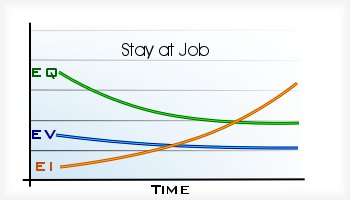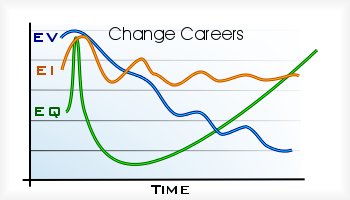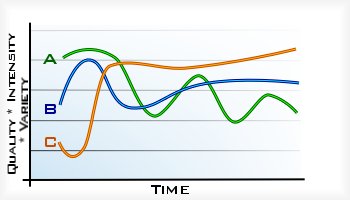Happiness is really hard to define. Why? Because happiness isn’t just one feeling (pleasure) or one experience (winning gold at the Olympics). Instead happiness is a broad assessment of a whole bunch of different experiences and feelings. Happiness isn’t usually a feeling itself, but an estimate of the average quality of your emotions.
Last week I wrote an article about a new strategy for happiness I called the emotional quality model. I received some great feedback, but I think it was a little too abstract to put into practice. I’d like to discuss how you can use this approach of seeking emotional quality to make decisions.
Three Components of Happiness – Variety, Depth and Quality
I’ve found there are really three components to happiness, variety, depth and quality:
- Variety – Imagine going to a restaurant where they served your favorite meal. Except that was the only meal they served you and you had to eat there for every meal of your life. Variety matters in tastes and it matters in happiness. When you only get one type of emotion repeatedly, it starts to lose power until it just becomes normal.
- Depth – This means the intensity of the emotion. It is the difference between feeling pleasant and feeling ecstatic. Intensity shouldn’t be constant (cycles between low and high) but with only neutral intensity life is boring.
- Quality – This means the difference between positive and negative. It’s all your perception, but I’d label certain emotions as having a high quality (enthusiasm, love, satisfaction) and other emotions as having a low quality (hate, depression, guilt).
The emotional quality model means you are making decisions in some attempt to improve one of these three factors. Either you want to add different types of emotions, you want to create greater cycles of emotional intensity or you want to improve the quality of your emotions.
That’s great but how do you actually use this to make decisions?
Emotional Decisions – Creating Ripples
Decisions aren’t linear in that they are one cause creating one effect, but like a stone being dropped into a pond, they ripple outwards, creating many effects. Deciding to start a business doesn’t just give you a business. It changes who you associate with, your investments, your way of thinking and your experiences.
Making decisions using the emotional quality model differ than the decisions most people make because you look for different effects, namely the changes in your emotional life.
Let’s say you are trying to figure out whether you should quit your job and pursue a new career. A hard decision to make by any standard, but how would you look at the problem from this new perspective? This graph shows each decision by estimating the impact on emotional quality (EQ), emotional variety (EV) and emotional intensity (EI):


This is a pretty generalized example, but as you can see changing careers will create different ripples. You will probably take a short-term dive in EQ (emotional quality) as you switch from comfort to survival. As you reestablish yourself, however, this EQ will begin to spike as you adapt to new living expenses and start working your passion. In contrast, your decision to stay at a job will slowly lower EQ and drastically cut EV (emotional variety) as you simmer at a job you dislike.
That was a pretty obvious example. You could have read any self-help book around and figured out that the intelligent (although scary) choice would be to get out of an environment you hate and pursue a job you love.
What about a decision that isn’t as rationally clear? Let’s say you were trying to decide between whether you should:
(A) Travel the world with less work (See 4-Hour Workweek)
(B) Work hard to establish your own business (See Steve Pavlina or Darren Rowse)
(C) Actively improve your intimate relationships (See AskDanandJennifer)

I’ve simplified the graph to compress more information, but if you really wanted to make your own, you would estimate how variety, quality and depth would be impacted by time for each decision. Total happiness being a product of all three.
Decisions like these are hard no matter what lens you use, but using traditional methods it is almost impossible. Normally trying to use logic to compare these decisions would be like comparing apples to giraffes wearing orange hats. Sure you can do a value assessment deciding if you think personal relationships are more important than world travel or business, but this basically comes down to making a gut decision that often isn’t useful.
With the EQ model, you actually have some basis to compare the results of these different decisions:
I’ve lumped all emotions together into variety, depth and quality, to simplify the diagram, but you can see how each would be filled with different emotions. World travel might create excitement, business could create challenge and satisfaction, personal relationships might create love.
Looking at this model you can get a rough prediction of how each will affect your happiness over different periods of time. Definitely a useful tool if you are trying to make big decisions.
Beyond Decisions – Using EQ for Synergy
The real place this model works, isn’t when you’re trying to compare options, but trying to create them. Using EQ means you get to examine how a decision will impact happiness at different times so you can create a better option.
Let’s say you have a long range goal to earn more money. Now you want to use the EQ model to figure out the best way to reach that goal. Obviously the best solution would be the one where all three components of happiness are maximized for the entire duration.
I recently used a similar process to this when making some decisions about how to create a sustainable income off this website. The problem wasn’t that I had too few options, but too many potential ones. I could write lots of posts and network with other bloggers to try to become an A-Lister, I could look into workshops/speaking gigs, I could work on products or another completely different approach.
Although all of these could work, some of my estimates suggested that working on products as a major focus would probably be the best decision in terms of EQ. More importantly, I decided that starting with smaller products before moving to larger ones would make the most sense for EQ.
Decision making is just one of many ways you can use the EQ model. I still recommend, as Steve Pavlina calls it, the, “Ready, Fire, Aim” approach to making decisions. Just as you won’t know what works best for external success, it takes experimentation to figure out what will work for EQ. The point is simply to give you a first estimate you can then make adjustments from.
I’ll probably cover more on EQ later, but I don’t want to hijack this blog too long with one topic. What are your thoughts on using emotional quality to guide decisions?


 I'm a Wall Street Journal bestselling author, podcast host, computer programmer and an avid reader. Since 2006, I've published weekly essays on this website to help people like you learn and think better. My work has been featured in The New York Times, BBC, TEDx, Pocket, Business Insider and more. I don't promise I have all the answers, just a place to start.
I'm a Wall Street Journal bestselling author, podcast host, computer programmer and an avid reader. Since 2006, I've published weekly essays on this website to help people like you learn and think better. My work has been featured in The New York Times, BBC, TEDx, Pocket, Business Insider and more. I don't promise I have all the answers, just a place to start.